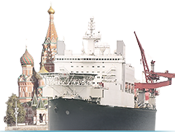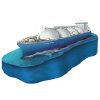Sea can go several kilometers deep. Laying a pipe at the bottom is a challenge. However, 6,000 kilometers of pipelines are laid at the bottom of the North Sea, some of which have been there for 40 years already.
 The world’s largest vessel, Solitaire, is 300 meters long and about 40 meters wide. This particular vessel is involved in the construction of the Nord Stream gas pipeline.
The world’s largest vessel, Solitaire, is 300 meters long and about 40 meters wide. This particular vessel is involved in the construction of the Nord Stream gas pipeline.

Searching for obstacles
Subsea gas pipelines account for 45 per cent of natural gas exports to Europe. Seabed is carefully surveyed along its entire route before laying the gas pipeline. Specialists must identify all potential obstacles including sunk ships, ammunition, and simply large boulders. These obstacles are either removed or bypassed. At this stage, specialists also identify locations where the pipelines should be buried or backfilled.
All pipes for future gas pipeline are subject to a special treatment. From the inside, they are treated with an antifriction coating which is reducing resistance during gas transmission. Externally, pipes are treated with an anticorrosion coating and then with a negative buoyancy concrete coating.
Floating houses
Pipes are laid on the seabed by special pipelaying vessels. Pipelaying vessels are huge floating platforms which can accommodate several hundreds of people at a time.
As a rule, several vessels participate in the process of pipe laying. Special barges continuously supply pipes to a pipelaying vessel, which is preceded by a vessel monitoring the seabed. The supplied pipes are unloaded on storage sites located directly on the deck of the pipelaying vessel. They should have a stock of pipes for 12 hours of work.
How pipes are laid
Special conveyor is installed on the pipelaying vessel, which receives pipes that are welded here as well. Each welded joint is then ultrasonically tested for defects. Anticorrosion coating is applied to all joints after welding. Welded pipes are moving over the conveyor towards the aft. Stinger, a special boom, immersed in the water at an angle, over which the pipes are gradually lowered onto the seabed, is located here. It defines the required deflection of the top part of the gas pipeline, which prevents metal deformation.
As a rule, pipes lie on the seabed under their own weight. They don’t need to be fixed, because each pipe weighs up to several tons after the concrete coating is applied. Pipes are laid in special trenches and backfilled with ground only in some locations, e.g. at landfalls, to ensure stability of the pipe.
From sea to shore
The process of laying a subsea gas pipeline normally starts not on the shore, as one could think, but in the sea. Gas pipeline can consist of several sections built at different times from different vessels and then connected to each other. Gas pipeline should be able to withstand different pressures in different sections, for this purpose pipes with different wall thickness are used.
Upon the completion of the subsea section construction, pipes are drawn on shore using a special winch installed on firm ground which is connected to the pipe with steel ropes and is slowly drawing it from the sea. The pipeline is then connected with its onshore section – a tie-in is made.
Hydro testing of the gas pipeline is a mandatory stage. For that, the pipeline is filled with water under requisite pressure and left for some time to identify possible defects. Condition of the gas pipeline is carefully monitored after its commissioning as well. Special electronic devices for in-pipe inspection are used in this process.

